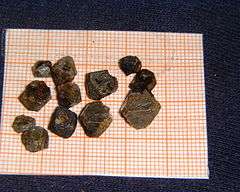Pyrochlore
| Pyrochlore | |
|---|---|
|
Pyrochlore from Uganda | |
| General | |
| Category | Oxide mineral |
| Formula (repeating unit) | (Na,Ca)2Nb2O6(OH,F) |
| Strunz classification | 4.DH.15 |
| Dana classification |
08.02.01.01 Pyrochlore group |
| Crystal system | Isometric |
| Crystal class |
Hexoctahedral (m3m) H-M symbol: (4/m 3 2/m) |
| Space group | Fd3m |
| Unit cell | a = 10.41(6) Å, Z = 8 |
| Identification | |
| Color | Black to brown, chocolate-brown, reddish brown, amber-orange, red-orange |
| Crystal habit | Typically octahedra, disseminated granular, massive |
| Twinning | 111 rare |
| Cleavage | 111 indistinct, may be a parting. |
| Fracture | Subconchoidal to uneven, splintery |
| Tenacity | Brittle |
| Mohs scale hardness | 5.0–5.5 |
| Luster | Vitreous to resinous |
| Streak | White |
| Diaphaneity | Subtranslucent to opaque |
| Specific gravity | 4.45 to 4.90 |
| Optical properties | Isotropic, weak anomalous anisotropism |
| Refractive index | n = 1.9–2.2 |
| Other characteristics | Variably radioactive, often metamict |
| References | [1][2][3][4] |
Pyrochlore (Na,Ca)2Nb2O6(OH,F) is a mineral group of the niobium end member (pyrochlore supergroup).
Occurrence
The mineral is associated with the metasomatic end stages of magmatic intrusions. Pyrochlore crystals are usually well formed (euhedral), occurring usually as octahedra of a yellowish or brownish color and resinous luster. It is commonly metamict due to radiation damage from included radioactive elements.
Pyrochlore occurs in pegmatites associated with nepheline syenites and other alkalic rocks. It is also found in granite pegmatites and greisens. It is characteristically found in carbonatites. Associated minerals include zircon, aegirine, apatite, perovskite and columbite.[2]
Name and discovery
It was first described in 1826 for an occurrence in Stavern (Fredriksvärn), Larvik, Vestfold, Norway. The name is from the Greek πῦρ, fire, and χλωρός, green because it typically turns green on ignition in classic blowpipe analysis.[3]
Crystal structure
Pyrochlore is also a more generic term for the pyrochlore crystal structure (Fd-3m). The more general crystal structure describes materials of the type A2B2O6 and A2B2O7 where the A and B species are generally rare-earth or transition metal species; e.g. Y2Ti2O7.The pyrochlore structure is a super structure derivative of the simple fluorite structure (AO2 = A4O8, where the A and B cations are ordered along the ⟨110⟩ direction. The additional anion vacancy resides in the tetrahedral interstice between adjacent B-site cations. These systems are particularly susceptible to geometrical frustration and novel magnetic effects.
The pyrochlore structure shows varied physical properties spanning electronic insulators (e.g. La2Zr2O7), ionic conductors (Gd1.9Ca0.1Ti2O6.9), metallic conductors (Bi2Ru2O7−y), mixed ionic and electronic conductors, spin ice systems (Dy2Ti2O7), spin glass systems (Y2Mo2O7), haldane chain systems (Tl2Ru2O7) and superconducting materials (Cd2Re2O7).[5]
Niobium mining
The three largest producers of niobium ore are mining pyrochlore deposits. The largest deposit in Brazil is the CBMM mine located south of Araxá, Minas Gerais, followed by the deposit of the Catalão mine east of Catalão, Goiás. The third largest deposit of niobium ore is Niobec mine west of Saint-Honoré near Chicoutimi, Quebec.[6]
Pyrochlore ore typically contains greater than 0.05% of naturally occurring radioactive uranium and thorium.[7]
See also
References
| Wikimedia Commons has media related to Pyrochlore. |
- ↑ Mineralienatlas
- 1 2 "pyrochlore at RRuff database" (PDF). rruff.info. Retrieved 2015-02-03.
- 1 2 "Pyrochlore Group: Pyrochlore Group mineral information and data.". mindat.org. Retrieved 2015-02-03.
- ↑ Barthelmy, Dave. "Pyrochlore Mineral Data". webmineral.com. Retrieved 2015-02-03.
- ↑ Subramanian, M. A.; Aravamudan, G.; Subba Rao, G. V. (1983-01-01). "Oxide pyrochlores — A review". Progress in Solid State Chemistry. 15 (2): 55–143. doi:10.1016/0079-6786(83)90001-8.
- ↑ Kouptsidis, J.; Peters, F.; Proch, D.; Singer, W. "Niob für TESLA" (PDF). Retrieved 2008-09-02.
- ↑ Dias da Cunha, K.; Santos, M.; Zouain, F.; Carneiro, L.; Pitassi, G.; Lima, C.; Barros Leite, C. V.; Dália, K. C. P. (May 8, 2009). "Dissolution Factors of Ta, Th, and U Oxides Present in Pyrochlore". Water, Air, & Soil Pollution. Springer Netherlands. 205 (1–4): 251–257. doi:10.1007/s11270-009-0071-3. ISSN 0049-6979.
- Atencio, D.; Andrade, M. B.; Christy, A. G.; Gieré, R.; Kartashov, P. M. (2010). "The pyrochlore supergroup of minerals: nomenclature". The Canadian Mineralogist. 48 (3): 673–698. doi:10.3749/canmin.48.3.673.
